Energy storage is essentially taking the energy produced at the moment and saving it for future use. Energy storage options for Microgrids have become highly promising and frequently discussed topics within the energy community. There are growing cybersecurity threats and frequent natural disasters that pose a risk to the bulk electric grid, which threatens the energy security of all those customers served by the electric transmission system. This has made microgrid solutions a desirable infrastructure improvement for utilities and customers. Energy storage is a flexible, versatile, and distributed energy resource that can significantly benefit a microgrid. Besides encouraging more renewable electricity generation, improved storage technologies have a lot of other benefits. Such benefits include a more efficient grid that cannot be affected by disruptions.
Use Of Batteries
One energy storage option for microgrids is the use of batteries. Battery energy storage systems (BESS) use lithium-ion, magnesium-ium, or another of a variety of options to store generated energy. Residential energy storage in backup power applications usually supports the energy needs in case the grid suffers a failure. Should there be a grid disruption, energy can be pulled from the batteries as far as the allowable discharge depth has been met. Batteries also come with different capacities. The microgrid owner should determine the amount of energy produced by the system before purchasing the storage batteries. Once the maximum output has been determined, batteries with the matching capacity can be purchased and integrated into the system. Should the microgrid go down, solar and wind provide a battery charging source, expanding the backup power accessibility from a specific period of hours per day.

Cheaper solar panels and longer-lasting batteries are quite attractive for microgrids. Batteries usually store energy during the peak production hours when the output is in oversupply. This bridges the gap when energy production during the night for solar panels or when the wind is not blowing. Batteries will also regulate peak consumption when the AC grid has been stressed to the breaking point.
Compressed Air Energy Storage (CAES)
During the low energy demand period, motors powered by the microgrid electricity are used to compress air and pump it into an underground cavern, some abandoned mines, or other large confined spaces. Later, the air is released and heated in order to release energy. The released energy can be used to turn small turbines to make electricity. This method of storing microgrid energy is relatively cheap and involves no toxic materials. However, a disadvantage arises from the fact that caverns or confined spaces are required for the storage of compressed air.
Pumped Hydro Storage
The renewable energy generated through wind and solar resources can be used to pump huge volumes of water from a lower reservoir to an upper reservoir. When the energy demand increases, the water is released from the upper reservoir to flow through turbines, which then generates electricity for use. Apart from microgrids, many of the main grids have stored their energy in the form of pumped hydro. This is another available option for storing microgrid energy. This option can store a large amount of energy as desired by the microgrid operators. However, this option requires space for both the lower and upper reservoirs.

Vehicle To Grid
Electric vehicles can also be utilized as batteries to store microgrid energy. They would be saving up energy at night when electricity demand is low. They would later send electricity back to the microgrid at peak times. An aggregator is used to pool the power into one specific large source. This option can be used anywhere with a parking spot and a plug. Car owners can receive compensation for the energy sent back to the microgrid utility. A disadvantage presented by this storage option is the possibility of the battery wearing out fast as a result of charging and discharging.
For more information about energy storage options for microgrids, contact a VECKTA specialist today.
Photo credits: (UniEnergy Technologies / Wikimedia) (dariusz piosik / Unsplash)
